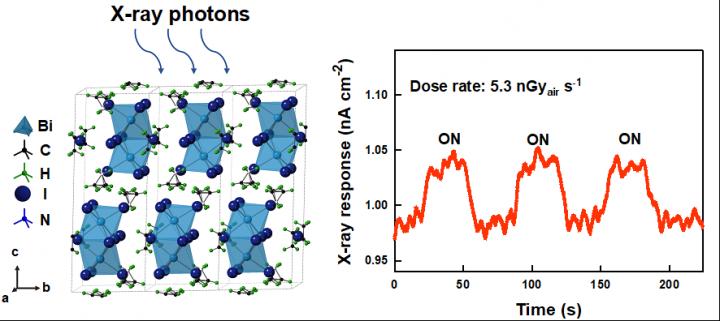
Single-Crystal MA3Bi2I9 Enables Ultra-Sensitive X-Ray Detection

X-ray detection down to nanograys per second by zero-dimensional MA3Bi2I9 single crystals
Credit: ©Science China Press
Researchers from China Academy of Engineering Physics, Nanjing University and University of Victoria demonstrated ultra-sensitive and stable X-ray detectors by using a new kind of 0D MA3Bi2I9 single-crystals.
The disconnecting of the (Bi2I9)3- units in the lattice leads to a high activation energy (Ea) for ion migration (0.46 eV) and is also accompanied by a low dark carrier concentration (~ 10 6 cm-3). The suppressed ion migration and lowered dark carrier concentration enable the desirable combination of high sensitivity, low LoD, and stable operation.
X-ray detectors with a low LoD of 0.62 nGyair s-1 was achieved with a 100 kVp tungsten-target X-ray tube, which approaches the background radiation on Earth (~0.1 nGyair s-1), and is significantly lower than the dose rate required for X-ray diagnostics (5.5 μGyair s-1).
Additionally, the reported X-ray sensitivity of 10,620 μC Gyair-1 cm-2 is comparable to the values obtained in 3D perovskite detectors (1.1 × 10 4 μC Gyair-1 cm-2 for MAPbI3 and 2.1 × 10 4 μC Gyair-1 cm-2 for hybrid MAPbBr3/Si) and 2D perovskite detectors (8,400 μC Gyair-1 cm-2 for (NH4)3Bi2I9).
It is worth noting that, unlike 2D hybrid Bi halide perovskites that cannot obtain low LoD and high sensitivity in the same direction, 0D MA3Bi2I9 X-ray detectors achieve simultaneously low LoD and high X-ray sensitivity in the out-of-plane transport mode.
The 0D perovskite X-ray detectors exhibit stable operation even under high applied biases up to 120 V. No deterioration in detection performance was observed following an X-ray irradiation dose of ~23,800 mGyair, equivalent to > 200,000 times of the dose used in acquiring commercial X-ray chest radiographs.
The advance presented herein provides a promising X-ray detector candidate in X-ray imaging and medical applications. This work was published in Journal of Energy Chemistry.
###
See the article: https:/
This work is supported by the National Natural Science Foundation of China (Grant Nos. 21773218, 61974063), the Sichuan Province (Grant No. 2018JY0206) and the Presidential Foundation of CAEP (Grant No. YZJJLX2018007).












